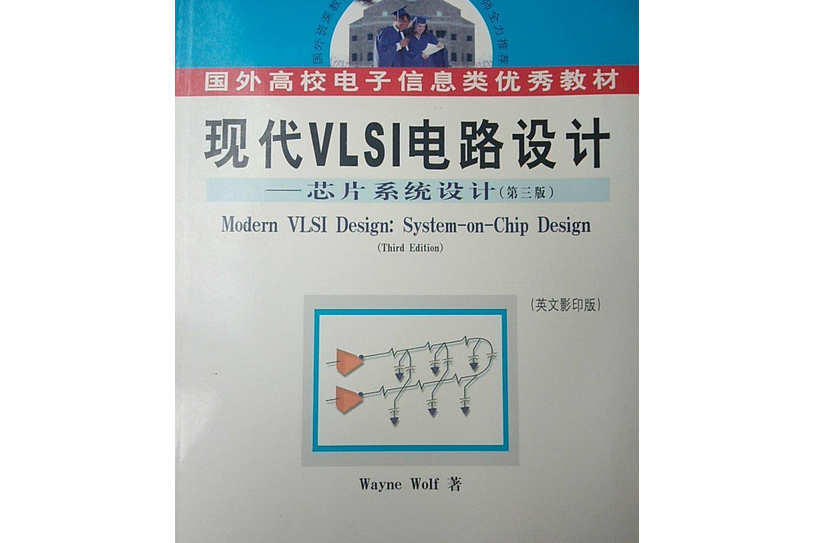《現代VLSI電路設計——晶片系統設計》是2003年3月科學出版社出版的圖書,作者是Wayne Wolf[美] 。
基本介紹
- 書名:現代VLSI電路設計——晶片系統設計
- 作者:沃爾夫
- 出版社:科學出版社
- 頁數:618 頁
- 開本:16 開
- 裝幀:平裝
- ISBN:7030111494
內容簡介,圖書目錄,
內容簡介
本書為國外高校電子信息類優秀教材(英文影印版)之一。
本書介紹了完整的VLSI設計過程——從物理設計到系統結構,為VLSI系統設計者提供了這一過程的全面介紹,同時對硬體描述語言VHDL進行了深入的討論。
本書可作為電子工程、計算機專業本科生教材,也可作為相關領域工程技術人員的參考書。
圖書目錄
Preface to the Third Edition
Preface to the Second Edition
Preface
1 Digital Systems and VLSI
1.1 Why Design Integrated Circuits?
1.2 Integrated Circuit Manufacturing
1.3 CMOS Technology
1.4 Integrated Circuit Design Techniques
1.5 A Look into the Future
1.6 Summary
1.7 References
1.8 Problems
2 Transistors and Layout
2.1 Introduction
2.2 Fabrication Processes
2.3 Transistors
2.4 Wires and Vias
2.5 Design Rules
2.6 Layout Design and Tools
2.7 References
2.8 Problems
3 Logic Gates
3.1 Introduction
3.2 Combinational Logic Functions
3.3 Static Complementary Gates
3.4 Switch Logic
3.5 Alternative Gate Circuits
3.6 Low-Power Gates
3.7 Delay Through Resistive Interconnect
3.8 Delay Through Inductive Interconnect
3.9 References
3.10 Problems
4 Combinational Logic Networks
4.1 Introduction
4.2 Standard Cell-Based Layout
4.3 Simulation
4.4 Combinational Network Delay
4.5 Logic and Interconnect Design
4.6 Pwer Optimization
4.7 Switch Logic Networks
4.8 Combinational Logic Testing
4.9 References
4.10 Problems
5 Seqential Machines
5.1 Introduction
5.2 Latches and Flip-Flops
5.3 Sequential Systems and Clocking Disciplines
5.4 Sequential System Design
5.5 Power Optimaization
5.6 Design Validation
5.7 Sequential Testing
5.8 References
5.9 Problems
6 Subsystem Design
6.1 Introduction
6.2 Subsystem Design Principles
6.3 Combinational Shifers
6.4 Adders
6.5 ALUs
6.6 Multipliers
6.7 High-Density Memory
6.8 Field-Programmable Gate Arrays
6.9 Programmable Logic Arrays
6.10 Refernces
6.11 Problems
7 Floorplanning
7.1 Introduction
7.2 Floorplanning Methods
7.3 Off-Chip Connections
7.4 References
7.5 Problems
8 Architecture Design
8.1 Introduction
8.2 Hardware Description Languages
8.3 Register-Transfer Design
8.4 High-Level Synchesis
8.5 Architectures for Low Power
8.6 Systems-on-Chips and Embedded CPUs
8.7 Architecture Testing
8.8 References
8.9 Problems
9 Chip Design
9.1 Introduction
9.2 Design Methodologies
9.3 Kitchen Timer Chip
9.4 Microprocessor Data Path
9.5 References
9.6 Problems
10 CAD Systems and Algorithms
10.1 Introduction
10.2 CAD Systems
10.3 Switch-Level Simulation
10.4 Layout Synthesis
10.5 Layout Analysis
10.6 Timing Analysis and Optimization
10.7 Logic Synthesis
10.8 Test Generation
10.9 Sequential Machine Optimizations
10.10 Scheduling and Binding
10.11 Hardware/Software Co-Design
10.12 References
10.13 Problems
A Chip Designer's Lexicon
B Chip Design Projects
B.1 Class Project Ideas
B.2 Project Proposal and Specification
B.3 Design Plan
B.4 Design Checkpoints and Specification
C Kitchen Timer Model
C.1 Hardware Modeling in C
Index

